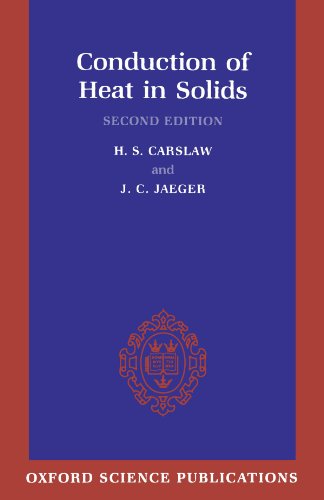Conduction of Heat in Solids ebook download
Par harris bernard le dimanche, août 23 2015, 22:07 - Lien permanent
Conduction of Heat in Solids. H. S. Carslaw, J. C. Jaeger

Conduction.of.Heat.in.Solids.pdf
ISBN: 0198533683,9780198533689 | 517 pages | 13 Mb

Conduction of Heat in Solids H. S. Carslaw, J. C. Jaeger
Publisher: Oxford University Press, USA
In solids, this transfer is called conduction. And Jaeger, J.C., Conduction of Heat in Solids, 2nd ed., Clarendon Press, Oxford, England, section 3.3, p. Thermal energy moves in three different ways: by conduction, convection and radiation. Conduction occurs mostly in solids. This can be understood if we see how solids, liquids and gases are bound to their respective atoms or molecules. Conduction: Heat is disorderly kinetic energy of molecules and/or vibration of molecules depending on if the matter is solid liquid or gas. The primary mode of heat transfer in solids is. The rate of heat loss on a cross bike will tend to be less than on a road bike, because the speeds are lower. Conduction is the transfer of heat along a solid object; it is this process that makes the handle of a poker hot, even if only the tip is in the fireplace. Conduction is heat loss that happens between two solids that are in contact with each other. The concept of air sealing ties in with how insulation works and how heat moves. Heat obtained by heat conduction, depends on properties of the material through which heat transfer. Simply put, when the heat is committed in one area next to the solid by molecular collisions. Asked by: kunal 35 views Heat_and_Temperature · science-5th. Heat can be transferred by three processes: conduction, convection, and radiation. Jaeger: Conduction of Heat in Solids (Oxford University Press, Oxford, 1959) p. For conduction of heat, a material medium is necessary. In the event that heat transfer occurs through several solids, the above equation can be adapted by supplementing the solid's thickness (L) divided by its thermal conductivity (λ). This process of heat flow is called conduction and happens in solids such as metals.This is because the particles or atoms are close together. More energetic molecules in a hot substance collide with less energetic molecules in a colder substance, transferring energy and therefore heat.
White Night (The Dresden Files, Book 9) pdf free